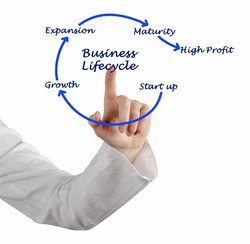As your small business grows and matures, your need for—and access to—capital will evolve. Here are some capital considerations as your business moves through the small business life cycle.
When your business was brand new, you had significantly different needs for capital than your longer-term, more established business needs today. Alternatively, if your small business is in its infancy, your need for capital will look much different five, ten, fifteen years down the road. What are these differences, and what can and should you do about them?
It’s useful to understand the typical small business life cycle so we can examine the need for capital at each stage.
- Establishment: At this stage, you’re creating the business, perhaps writing a business plan that will become the foundation for your go-to-market strategy. Small business owners will require varying amounts of capital but have a handful of avenues available to them. These may include traditional small business lending avenues, such as banks and credit unions. Some small business owners will explore their funding options with venture capital firms and/or angel investors. The Small Business Administration, which doesn’t provide funding or grants itself, does help small business owners secure the funding they need to establish their business.
- Growth: Your small business has made it through its early days, gradually increasing revenues to escape negative profits and to begin breaking even. Businesses at this stage require effective financial and operational management to survive. At this point, retained earnings may play a role in growing the business, but it’s also likely you’ll continue to rely on third party lending. Funding resources from the establishment stage will apply to the growth stage, and if your small business accepts credit cards for customer payments, you can begin to explore how a merchant capital advance could benefit your growth plans.
- Expansion: Small business revenue has increased, and you have begun adding staff, investing in office space and/or equipment, and are supporting at a larger customer base. With revenues on the rise, you may find that your need for outside capital has diminished; that is, you may be able to rely on your own cash flow to fund your expansion. But merchant cash advance may be an option to consider during this phase if you’re looking for a short-term, quick cash infusion, particularly for projects like remodeling your facility, or for adding equipment or resources to accommodate a project.
- Maturity: Mature small businesses have “enough backing, capital, and support to ensure that even if the market becomes unstable, [they] can pull through.” During unstable conditions, these small businesses may need to accept diminishing profits, or will need to adjust managerial approaches and strategies. In any case, the need for outside capital during the maturity stage may closely resemble the expansion stage, and thus the options remain the same.
- Decline: Even mature businesses may one day begin to decline, or perhaps fail. Here, small business owners’ options may be limited as traditional financing resources are reluctant to lend to failing businesses. But when small business owners are committed to fixing what’s broken in the business, they’ll need to explore options for outside capital. Alternative lenders, angel investors, and venture capital firms may prove to be invaluable resources to businesses in decline.
Although not every small business advances through the life cycle at the same pace, nor will every small business go through every stage, understanding your options and considerations at each stage will help contribute to your business’s long-term success.

